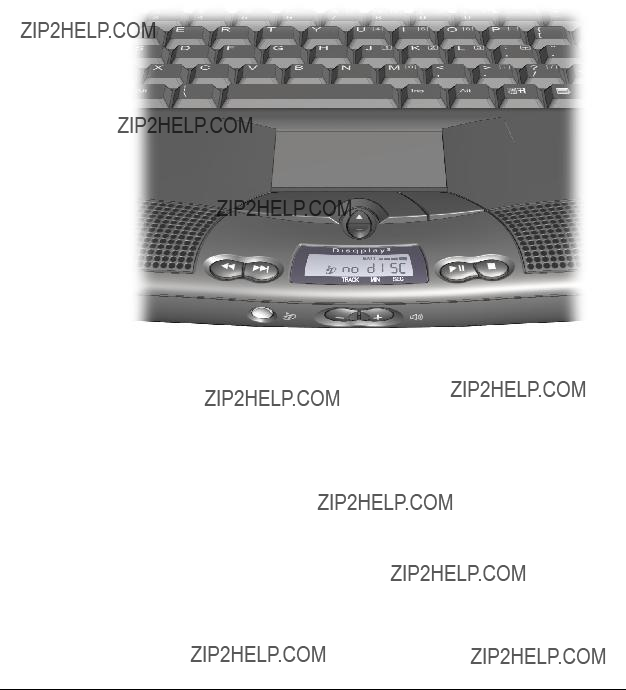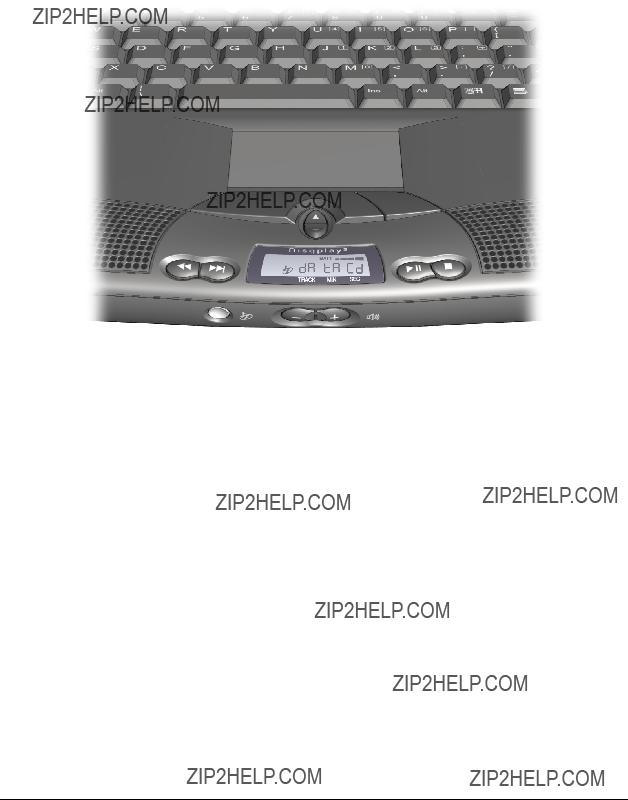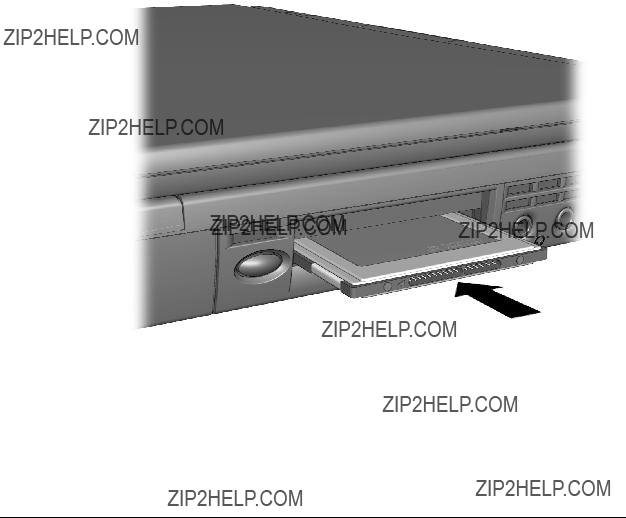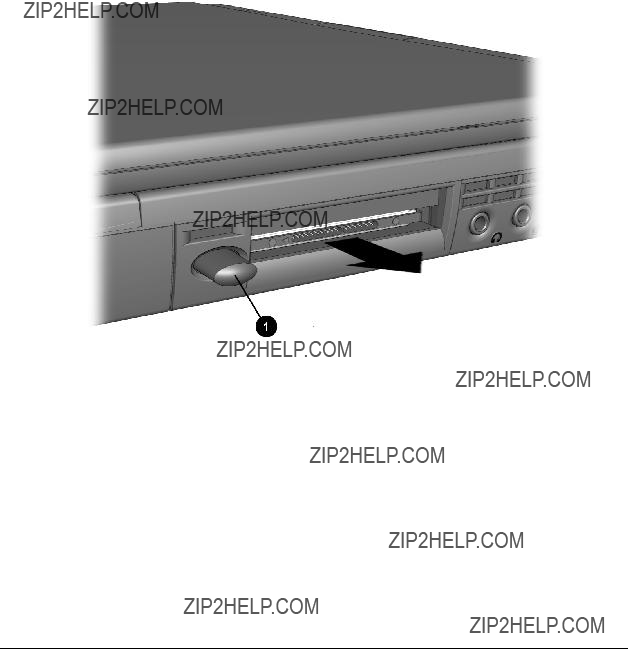

Table of Contents i
Contents
CHAPTER 1
CHAPTER 2
CHAPTER 3
CHAPTER 4
CHAPTER 5

Chapter 1
Using This Guide
Thank you for buying a Compaq Mobile Internet PC. This Features Guide will help you to familiarize yourself with the features of your Internet PC, as well as give you information on how to upgrade your computer.
Please take a moment to familiarize yourself with the special text and messages used throughout this guide.
Text Conventions
The examples below explain the specially formatted text used in this guide.
???Keyboard key names appear in bold type: Home, End, Backspace, Tab
???Keyboard keys that must be pressed at the same time to perform a task appear in bold type with a plus (+) between the key names: Ctrl+Home
???Drives appear as capital letters: drive C
???Folder names appear with initial capital letters: Favorites
???File names appear in italics with an initial capital letter: Setup.exe
???Command line statements appear in lower case bold type: a:\install
???Names of icons appear in bold type followed by a picture of the icon:
My Computer G icon
???Menu items appear in bold type: Programs, Accessories

Special Messages
The following words and symbols have special meaning in this guide.
*HINT: Helpful hints that will make using your computer easier and faster.
+NOTE: Important information concerning the operation of your Internet PC.
`CAUTION: Failure to follow directions may result in equipment damage or loss of data.
aWARNING: Failure to follow directions may result in bodily harm or loss of life.
Locating Help
Compaq provides you with several resources to help you learn about your Internet PC. These resources include the following:
Glossary
Computer terms that may be unfamiliar to you are identified in the glossary.
Index
The index is a comprehensive list of the topics covered in this guide.
Troubleshooting
The Troubleshooting section shows how to fix many common

Understanding Your Service and Support Options
Your Internet PC is equipped with several helpful programs that will aid you in identifying and solving common computer problems.
If you need further technical support, visit the Compaq Web site at:
www.compaq.com/athome/support
Compaq Technical Support telephone numbers are listed in the Limited Warranty Statement.
+NOTE: Locate the model and serial numbers for your computer before you call technical support. Write these numbers down for future use.
Comments about this Guide
Compaq Computer Corporation welcomes comments and suggestions you may have concerning this guide. Send correspondence to the following address:
COMPAQ COMPUTER CORP
ATTN: DOCUMENTATION PROGRAM MANAGER MAIL CODE 060504
20555 SH 249 HOUSTON TX 77070
+NOTE: This address is for comments and suggestions only. It is not for the purpose of obtaining technical assistance.


Chapter 2
Introducing Your Mobile Internet PC
Checking Your Connections
Your Computer Connections
Connections
2Battery

Front of Your Mobile Internet PC
The following buttons, lights, and controls are located on the front of your computer:
Front of Your Computer
Front Components

Internet Zone Buttons and Lights
Internet Zone Buttons and Lights

Front of Your Computer
Front Components
Refer to the Understanding the Status Display section in this guide for more details about the icons found on the display.

Using Your Keyboard to Access the Internet
The Compaq Internet Zone buttons provide quick, easy access to the Internet.
Internet Zone Buttons
The Internet Zone buttons, located at the top of the keyboard of your Mobile Internet PC, automatically connect you to the Internet. Before using these buttons, you must have access to the Internet. These buttons give you quick access to the most frequently used Internet activities. These buttons are programmed to do the following:
Internet Zone Buttons
3filled with local weather, news, sports, and financial information.Instant Internet Access connects you to a personalized Web page
2For AOL subscribers, this button opens your AOL
??convenience of catalog shopping at the touch of a button. In some regions, the Featured Website button replaces the Instant

Reprogramming Your Internet Zone Buttons
You can reprogram the Internet Zone buttons to reflect your personal preferences.
The Easy Access Internet Zone ??icon is located on the Windows Taskbar. It can also be reached by clicking the Start button, then Programs and choosing
Reprogram Easy Access Buttons.
To reprogram your Internet Zone buttons, complete the following steps:
1.From the Status bar,
2.From the Compaq Easy Access Button Settings window, click the button you wish to change.
3.Follow the instructions provided.
Disabling and Enabling the Internet Zone Buttons
You may turn off all Internet Zone buttons from the Easy Access Button program. When turned off, no Internet Zone buttons will operate. The Easy Access Internet Zone ??icon located on the Taskbar will appear with a red X on top. You can still access the button functions if you click the Easy Access Internet Zone ?? icon.
To disable the Internet Zone buttons, complete the following steps:
1.From the Windows Taskbar,
2.Click Disable Easy Access Buttons.
To enable the Internet Zone buttons, complete the following steps:
1.From the Windows Taskbar,
2.Click Enable Easy Access Buttons.

Left Panel of Your Mobile Internet PC
The following components are located on the left panel of your computer:
Left Panel of Your Computer
Left Panel Components

Right Panel of Your Mobile Internet PC
The following components are located on the right panel of your computer:
Right Panel of Your Computer
Right Panel Components

Back Panel of Your Mobile Internet PC
The following components are located on the back panel of your computer:
Back Panel of Your Computer
Back Panel Components

Bottom of Your Mobile Internet PC
The following components are located on the bottom of your computer:
Bottom of Your Computer
3Memory Compartment

Inserting the Battery
To insert your battery into the battery compartment, complete the following steps:
1. Push down on the battery compartment door to remove the door.
Inserting the Battery
2.Insert the new battery 1 into the battery compartment with the label side turned up.
+NOTE: Only Compaq 1600 Series Mobile Internet PC batteries should be installed in your computer.
3.Close the battery compartment door 2 by gently pushing up on the door until it snaps into place.

Removing the Battery
To remove the battery, complete the following steps:
1.Save your files.
2.If the AC adapter is not connected, turn off your computer.
3.Remove the battery compartment door by sliding it down.
4.Use the tab on the battery to pull the battery out.
acrush, puncture, or incinerate the battery or short the metal contacts. Do not attempt to open or service the battery.WARNING: To reduce the risk of damage to the battery or personal injury, do not
Charging the Battery
Charge the battery by connecting your computer to AC power. The battery receives a charge whether your computer is on or off and continues charging until the battery is fully charged or the AC power is disconnected. The Battery Charging ??icon is displayed when the battery is charging.
NOTE: When you charge the battery the first time, leave your computer plugged into
+the electrical outlet until the battery pack is fully charged and the Battery Charging ??icon is no longer displayed. This measure ensures that your battery is completely charged.
Battery Charging Time
Battery charging time will vary based on the initial battery charge, the type of battery, and the activity of your computer while charging.
Spare or Extra Batteries
To purchase extra batteries for your Compaq Internet PC, contact an authorized dealer or the Compaq Web site at:
www.compaq.com/athome
Next, click onlinestore???accessories???notebook options???accessories or call 1-

Plugging In Your Computer to AC Power
To connect your computer to AC power, follow the instructions on the Compaq Hardware and Software Setup poster. Refer to the Government Approvals section of the Mobile Internet PC Reference Manual for worldwide power cord information.
Unplugging the Computer from AC Power
When your computer does not have a charged battery, you should save your work and turn off the computer before unplugging it from AC power.
When a charged battery is in the computer, you can simply unplug it from AC power. The computer automatically switches to battery power.
WARNING: Make sure you can easily reach the electrical outlet. Unplug the AC adapter from the electrical outlet when you want to disconnect power from your computer. Do not leave the AC adapter plugged into the electrical outlet.
aWARNING: Do not place anything on power cords or cables. Arrange them so that no one will accidentally step on or trip over them. Do not pull on a cord or cable. When unplugging from the electrical outlet, grasp the cord by the plug.
WARNING: To reduce the risk of electrical shock, fire, or damage to the equipment, do not use converter kits sold for appliances to power your computer.


Chapter 3
Mobile Internet PC Features
Turning On Your Mobile Internet PC
To turn on your computer, press the Power ???button, which is located at the top of the keyboard.
Turning Off Your Mobile Internet PC Properly
Standard Off Mode
To turn off your computer properly, complete the following steps:
1.Save any work you want to keep by clicking the File menu, then clicking Save. If the Save As window is displayed, type in a file name and specify where you want to save the file, then click the Save button.
2.Exit the program you are using by clicking the Close button in the top right- hand corner of the window.
3.Maximize and close any windows shown on the Taskbar at the bottom of the screen.
4.Repeat steps 1, 2, and 3 for each window you have open until only the Windows desktop remains active.
5.Click the Start button, then click Shut Down.
6.Select the Shut down option.
7.Click the OK button. After a few seconds, your computer will turn off.
+NOTE: Your computer cannot receive faxes when it is turned off or in Hibernation mode.

Full Off (Main Power Off) Mode
If you need to install or replace components in your computer, you must turn your computer off completely. To do this, complete the previous steps for putting your computer into Standard Off mode. Unplug the computer electrical cord from the outlet and remove the battery if installed.
Recovering from a Locked Program or System
Recovering from a Locked Program
To recover from a frozen software program, complete the following steps:
1.Press Ctrl+Alt+Delete. The Close Program window displays.
2.Select the program that is not responding.
3.Click the End Task button. A message displays prompting you to close the program that is not responding.
4.Click End Task.
+NOTE: Learn to save your work often. Work that has not been saved may be lost when a program or the computer stops responding.

Recovering from a Locked System
Occasionally you may encounter a nonworking keyboard or a frozen screen. To restart your computer, complete the following steps:
1.Press and hold down the Power ???button for at least four seconds. This action will cause a manual shutdown.
2.Press the Power ???button once to restart.
If your computer still does not restart, complete the following steps:
1.Remove the battery and unplug the AC power for at least 30 seconds.
2.Reinsert the battery or reconnect AC power and press the Power ???button once to restart.
If files were open when the computer locked up, ScanDisk, a Microsoft Windows utility program, will automatically run. ScanDisk will determine if the improper shutdown caused any errors on the hard drive. Errors may occur if the Microsoft Windows operating system was not able to properly close all files before the shutdown. If no errors are found, the restart process will continue. If ScanDisk does detect errors, follow the instructions shown to continue the restart process. Work that was not saved prior to the lockup may be lost.

Using the Numeric Keypad
To use the embedded numeric keypad, press Fn+NumLk. This key combination switches the keys to numbers until you press Fn+NumLk again. When NumLock is activated, the NumLock hlight is turned on.
+on the notebook keyboard will not activate NumLock. You must press the NumLock key on the external keyboard or numeric keypad to activate NumLock.NOTE: If an external keyboard or numeric keypad is connected, pressing Fn+NumLk
Numeric Keypad

Using the Scroll Button
If you are using a program that has a vertical scroll bar, the scroll button beneath your touchpad will allow you to scroll up and down a page.
To change the function of the scroll button, complete the following steps:
1.Click the Start button from the Windows Taskbar.
2.Point to Settings, then click Control Panel.
3.
4.Click the Button Actions tab. Change the selection in the Rocker Switch column of the Buttons panel.
Understanding Your Computer Status Lights
Status lights show what is happening in your computer.
??AC Adapter ??? AC adapter is plugged in.
eCaps Lock ??? This feature is activated. When used, letters are typed in uppercase. To turn Cap Lock on, press the Caps Lock key.
hNum Lock ??? This feature is activated. You can use the embedded keypad to enter numbers. To turn on Num Lock mode, press Fn+NumLock.
Scroll Lock ??? This feature is activated. Text that takes up more than a full
gscreen scrolls up the screen
ScrLock key.

Understanding Your Status Display
The icons on your computer status display show what is happening in your computer. If you press any of the buttons around the status display (except the Volume Up or Volume Down buttons), it will light up for a few seconds so that you can see the icons more clearly.

Using the Function Keys
Use the function keys on the keyboard to perform repeated tasks quickly. The function keys are located on the top row of the keyboard. The Fn key activates a function key. It is located in the
To use a function key, press the Fn key at the same time you press a function key.
Function Keys and Fn Key

The F1 and F2 keys can also be set up to open your most
Refer to the Reprogramming Your Internet Zone Buttons and Function Keys section in this guide for more information about programming the F1 and F2 keys.
The following keys have already been assigned:
* Available only on select models

Adjusting the Volume
You can change the speaker volume on your Internet PC. Press the ??button to increase the volume. Press the ??button to decrease the volume. Pressing the ?? and ??buttons at the same time will turn on and turn off the mute feature.
aWARNING: To reduce the risk of personal injury or equipment damage, reduce the speaker volume before putting on headphones.
Adjusting the Volume Using Windows
To adjust the volume using Windows,
Using Disqplay2
Your Compaq Internet PC features Disqplay2 technology. Disqplay2 allows you to play CDs on your Internet PC while main power is turned off, a convenient way to play CDs while greatly reducing the amount of power used by your computer.
With Disqplay2 you can:
???Insert an audio CD and it will automatically start playing.
???View the total playing time and number of tracks on an audio CD when it is stopped.
???View the track number and time remaining within the track.
???Fast forward or rewind within a CD track.
???Continuously repeat a track or repeat an entire disc once it has reached the end of the last track.
???Press a button (except for Volume Up or Volume Down) and your status display will light up for a few seconds so you can see the icons more clearly.
Disqplay2 will also turn itself off if your CD has stopped playing and no activity has occurred for a certain amount of time.

For a list of the buttons used to operate Disqplay2, please see the table below.
*Pressing the Volume Down and Volume Up buttons at the same time will turn on and turn off the mute feature.

Mobile Internet PC Features
Playing Audio CDs Using Disqplay2
To play an audio CD using Disqplay2, press the Disqplay2 On/Off Rbutton for 1 second to turn on Disqplay2, then insert the CD into the CD drive. The CD will automatically start playing. Use the CD control buttons to navigate the CD.
If there is no CD in the CD drive, a No Disc message will appear on the status display.
No Disc Message

If there is a data
Data CD Message
Using Repeat Track
To continuously repeat a track, complete the following steps:
1.While the track is playing, press the Play/Pause ??button.
2.Press the Previous Track ??button. The Repeat ??icon will appear on the status display and the track will start playing.
3.Press any button to stop the track from repeating.
Using Repeat All
To continuously repeat a CD, complete the following steps:
1.While the track is playing, press the Play/Pause ??button.
2.Press the Next Track ???button. The Repeat All ???icon will appear on the status display and the track will start playing.
3.Press any button to stop the CD from repeating.

Mobile Internet PC Features
Setting Up Your
Your Mobile Internet PC comes with a composite
With a
???Play games on a bigger screen, such as your television.
???Watch DVD movies on TV rather than a computer monitor.
???Play a video clip for recording on a VCR.
Connecting and Enabling
To connect your computer and your television, you will need a composite video cable (RCA cable) to plug into your TV, VCR, or other device. These cables can be purchased in a retail TV store or a computer store.
To connect and enable
1.Connect your TV to your computer.
2.Turn on the TV, then turn on your computer or if your computer is already on, restart it.
3.
4.Click Properties.
5.Click the Settings tab, then click the Advanced button.
6.Click the Display Devices tab.
7.Click the TV Radio button under Display Devices and click the Apply button to select the TV output.
8.Click the OK button to activate the warning message that verifies that the TV is turned on and is plugged into the computer.

9.Click the OK button to confirm the change or after 15 seconds, the original settings will be restored.
10.Click the OK button to exit the Advanced menu and the Display Properties menu.
+Underscan mode

Mobile Internet PC Features
Setting Up Your Television Format
To properly view images, you must set your computer to your country???s standard for television transmission. To do this, complete the following steps:
1.
2.Click Properties.
3.Click the Settings tab, then click the Advanced button.
4.Click the Display Device tab.
5.Click the TV Standard dropdown box.
6.Scroll to find your TV format, then select it.
7.Click the OK button to exit the Advanced menu and the Display Properties menu.
Your television format is now set.
Adjusting the Television Screen
After you have enabled your television, you may need to adjust the size or location of your screen.
To make adjustments to your screen, complete the following steps:
1.
2.Click Properties.
3.Click the Settings tab, then click the Advanced button.
4.Click the Television tab.
a.To change Tint, Saturation of the screen or Brightness, use the sliders under Color Adjustment.
b.To change the position, click the arrow buttons next to Position.
5.Click the OK button to exit out of the Advanced menu and the Display Properties menu.

Switching Between Displays
You can switch between your television and your display or external monitor by pressing Fn+F3. The order in which they change is:
???External Monitor
???Display and External Monitor
???
???Display
The
The

Chapter 4
Learning About Your Modem
Your Internet PC is equipped with a 56K V.90 data/fax modem. Before using your modem to connect to the Internet, you must establish an account with an Internet service provider (ISP).
Performance Features
Your modem has several features that significantly enhance its performance. These features include the following:
???56K ITU V.90 compliant ??? Your modem is ready to operate using the International Telecommunications Union V.90 standard.
???K56flex compliant ??? If your ISP uses the K56flex protocol, the modem will automatically use this protocol to establish a connection.
???Data/fax capable (refer to the Sending and Receiving Faxes section).
Identifying Your Modem
To learn more about the modem installed on your computer, complete the following steps:
1.From the Windows Taskbar, click the Start button, point to Settings, and then click Control Panel.
2.
In the Modem Properties window, the names of the installed modems are displayed.

56K ITU V.90 Standard
If you are able to connect to an ISP using the V.90 standard, the modem will be able to download files at a maximum speed of 56 kilobits per second (Kbps), over standard telephone lines. Download speeds will vary with telephone line conditions.
When using the V.90 standard, download speeds are faster than upload speeds. The maximum download speed is 56 Kbps and the maximum upload speed is
33.6 Kbps. Transmission rates will vary depending on telephone line conditions.
The V.90 and K56flex protocols are designed only to increase the download transmission rate from V.90 or K56flex compliant digital sources. Maximum achievable download transmission rates are currently unknown, may not reach 56 Kbps, and will vary with telephone line conditions.

Chapter 5
Upgrading Your Mobile Internet PC
Adding More Memory
Memory upgrades of 32, 64, or 128 megabytes (MB) of random access memory (RAM) are available for your computer. Contact your Compaq retailer, seller, or authorized dealer for information on memory or refer to your accessories catalog.
The memory specifications for your Mobile Internet PC are as follows:
???
???SyncDRAM (synchronous dynamic random access memory)
???3.3 volt
Select PC100 compatible memory if your system is equipped with a Celeron??? processor. Select PC133 compatible memory if your system is equipped with a Pentium III??? processor.
`beginning this procedure, make sure you are properly grounded (discharged of static electricity) by briefly touching a grounded, unpainted metal object or surface.CAUTION: Electrostatic discharge can damage electronic components. Before

Installing Memory Expansion Modules
`expandingwarranty issues.memory. The use of
To properly install memory modules, complete the following steps:
1. Turn off your computer using the Windows shutdown process.
`CAUTION: If you enter Hibernation mode instead of turning off your computer when adding memory, you will lose data.
2.Disconnect all power sources and external hardware from your computer.
3.Remove the battery from its compartment.
4.Turn your computer over and locate the memory compartment door.
5.Use a Phillips screwdriver to remove the screw from the memory compartment door.
6.Remove the memory compartment door.
7.Slide 1 and lock 2 the memory expansion module in place.
`whenmodule.inserting the memory module. Excessive pressure can damage the memoryCAUTION: When installing memory expansion modules, apply gentle, even pressure
+ NOTE: Make sure the memory module is properly seated and snapped into place. If it is not seated, you may see memory error messages or your computer may not recognize the memory module.

Installing the Memory Expansion Module
8.Replace the memory compartment door.
9.Reinsert the screw.

What Are PC Cards?
PC Cards (formerly known as PCMCIA Cards) are removable devices that increase the storage or communications capability of your computer. PC Cards come in three different sizes: Type I, Type II, and Type III. PC Cards have the following things in common:
???2 standard bus sizes,
???
???approximately the same size as a credit card, but differences in thickness
PC Cards are easy to install. Other issues, however, especially software considerations, can impact your ability to use them effectively.
The Personal Computer Memory Card International Association (PCMCIA) was formed in 1989 to set industry standards for the use of PC Card technology. PCMCIA represents more than 500 companies in the computer industry. As a member of PCMCIA???s Board of Directors and Executive Committee, Compaq is a driving force in the PC Card industry.
PC Card Types
PC Card types vary as follows:
???Type I cards are usually memory cards and are the thinnest at 3.3 mm.
???Type II cards, such as modem cards, are 5.0 mm thick.
???Type III cards, typically hard disk drives, are the thickest at 10.5 mm.
???Extended Type I, Type II, and Type III PC Cards are the same height and width as standard size PC Cards. They have added length or thickness at one end so they can accommodate external connectors or wireless PC Card antennas.

Inserting a PC Card
To insert a PC Card into your computer, complete the following steps:
1.Guide the PC Card, label side up, through the lower door of the PC Card slot.
2.Gently push the card into the slot. If the computer is turned on, the computer automatically configures the PC Card and beeps when the card is ready to use.
+NOTE: Your 1600 Series notebook will only accept one PC Card of any type at one time.
`CAUTION: Do not force the card into the slot, as this may damage the connector pins.
Inserting a PC Card

Removing a PC Card
If your computer is turned on, click on the PC Card O icon on the Windows Taskbar to stop card activity before you remove the card. A popup window prompts you to remove the card. Then, follow these steps to remove the PC Card:
1.Push in on the recessed PC Card Eject button 1 to extend it.
2.Push the extended button back into the unit. The PC Card pops out, and if the computer is turned on, the computer will beep.
3.Gently grasp the card and pull it out completely.
Ejecting a PC Card

Internet PCs are compatible with many PC Cards and CardBus PC Cards on the market today. Refer to the documentation that came with your PC Card or contact your PC Card manufacturer for information. The Compaq Web site lists many compatible PC Cards:
www.compaq.com/athome/support/serv_note.html
+NOTE: Before buying a
Using Network PC Cards
Your Internet PC can support many types of
The Microsoft Windows 98 Getting Started guide and the documentation that came with your network card will have more information about setting up to use a network or compatible network card.
Compaq Netelligent PC Card is one of the compatible network PC Cards you can use with your computer. The Compaq Web site lists many compatible network cards:
www.compaq.com/athome/support/serv_note.html
If your computer came with an integrated Ethernet controller, you will not need a PC Card to connect to a network.

PC Card Software
Some types of PC Cards require
Configuring PC Cards
The PC Card software needed to easily install and configure PC Cards in Windows is provided on your Internet PC.
You do not need to turn off your computer or initiate Sleep mode before inserting a PC Card.
When you insert a PC Card for the first time, Windows identifies the new hardware and automatically determines the correct settings for the card to install the needed PC Card drivers. You may be prompted to make simple setup choices. Once you have completed setup for a PC Card, each time you insert that card, Windows remembers the correct settings and configures it automatically.
Depending on the card and the version of PC Card software you are using, you may have to turn on PC Card drivers or install device drivers. Your computer features

PC Card vendors provide the following types of PC Card software:
Direct or point enabler ??? An enabler is proprietary software, which means it is designed to support only the card it comes with. An enabler can prevent your computer from working with other PC Cards. When an enabler is used, you lose the benefits of your existing PC Card software. You lose features such as Power Management, Sleep, Hibernation, support for other PC Cards, and the ability to hot plug (to insert cards without restarting your computer).
Enabler software should only be installed by an experienced user. In fact, an enabler is rarely needed.
NOTE: An enabler can disable your computer???s ability to function with another PC Card. As a precaution, copy your important files to a diskette before installing an
+enabler.
NOTE: All Compaq computers with PC Card slots already have PC Card software loaded. Do not install


Index
A
AC adapter
connecting
B
battery
charging time
buttons
CD/DVD eject
Instant Internet Access
left touchpad
My Presario
PC card eject
scroll lock
stop
volume down
C
CD/DVD drive
manual eject hole
adjusting volume
full off
main power off
TV out
AC adapter
D
diskette
drive
eject button
display
display release latch
buttons
next track button
playing CDs
repeat track
download speeds
CD/DVD
F
fan vent
using
Instant Internet Access
International Telecommunications Union
Internet PC
ITU See International Telecommunications Union
J
jack
headphone
K
K56flex
numeric keypad
H

N
numeric keypad
P
PC cards
compatible network cards
definition
software
type II
PCMCIA See PC Cards ports
modem
speaker
power
button
main power off
R
restarting the computer
S
Scandisk
securing your computer security slot
T
turning on and off your computer
adjusting television screen
displays
U
upload speed
V
V.90 standard
adjusting
W
write protecting

The information in this guide is subject to change without notice.
COMPAQ COMPUTER CORPORATION SHALL NOT BE LIABLE FOR TECHNICAL OR
EDITORIAL ERRORS OR OMISSIONS CONTAINED HEREIN; NOR FOR INCIDENTAL OR
CONSEQUENTIAL DAMAGES RESULTING FROM THE FURNISHING, PERFORMANCE,
OR USE OF THIS MATERIAL.
This guide contains information protected by copyright. No part of this guide may be photocopied or reproduced in any form without prior written consent from Compaq Computer Corporation.
?? 1999 Compaq Computer Corporation. All rights reserved. Printed in the U.S.A., Brazil, Canada, Japan, Korea, Singapore, Taiwan, and the U.K. Compaq and Presario are registered in the U.S. Patent and Trademark Office.
Microsoft,
The software described in this guide is furnished under a license agreement or nondisclosure agreement. The software may be used or copied only in accordance with the terms of
the agreement.
Product names mentioned herein may be trademarks and/or registered trademarks of their respective companies.
1 5 8 5 6 2 - 0 0 1